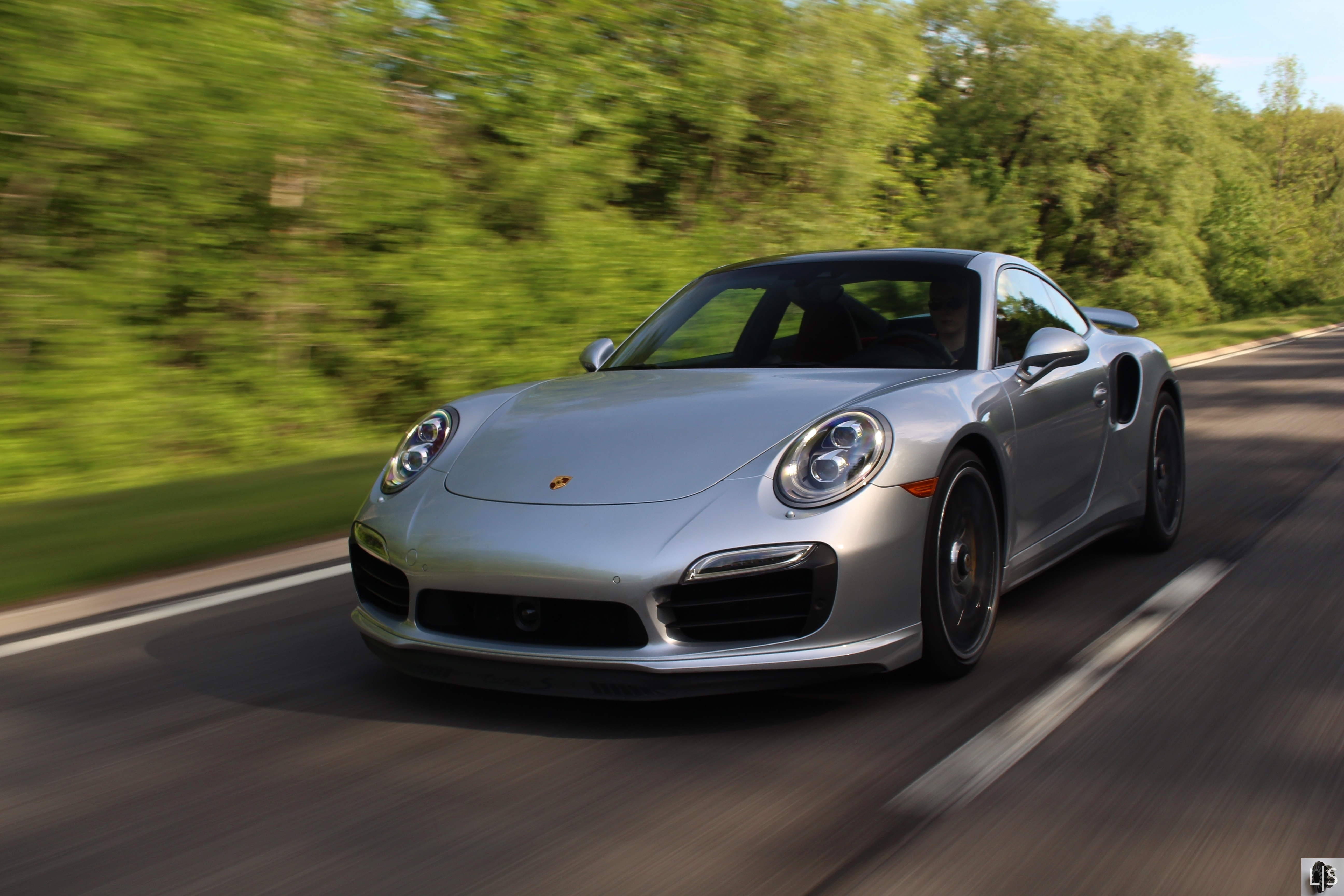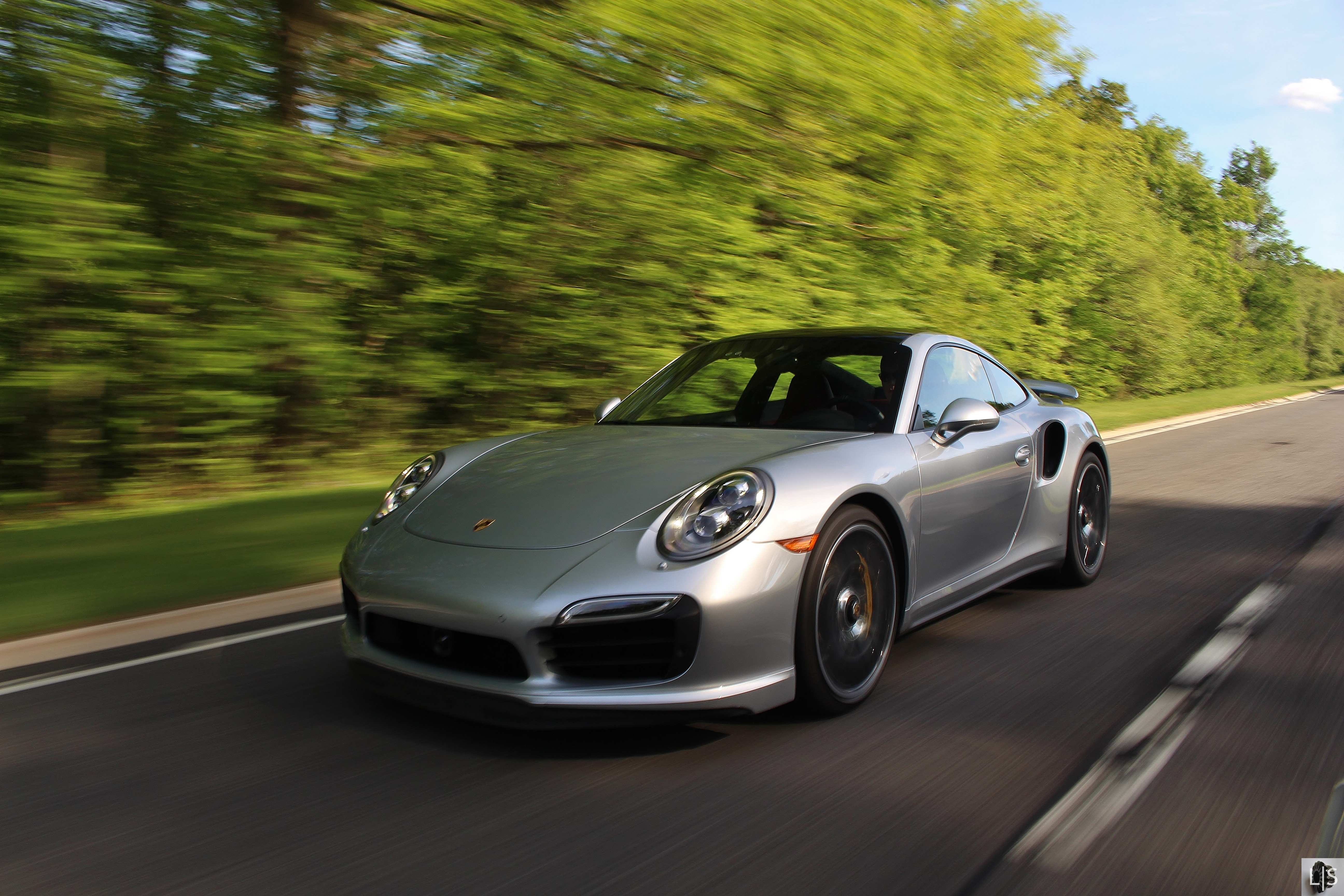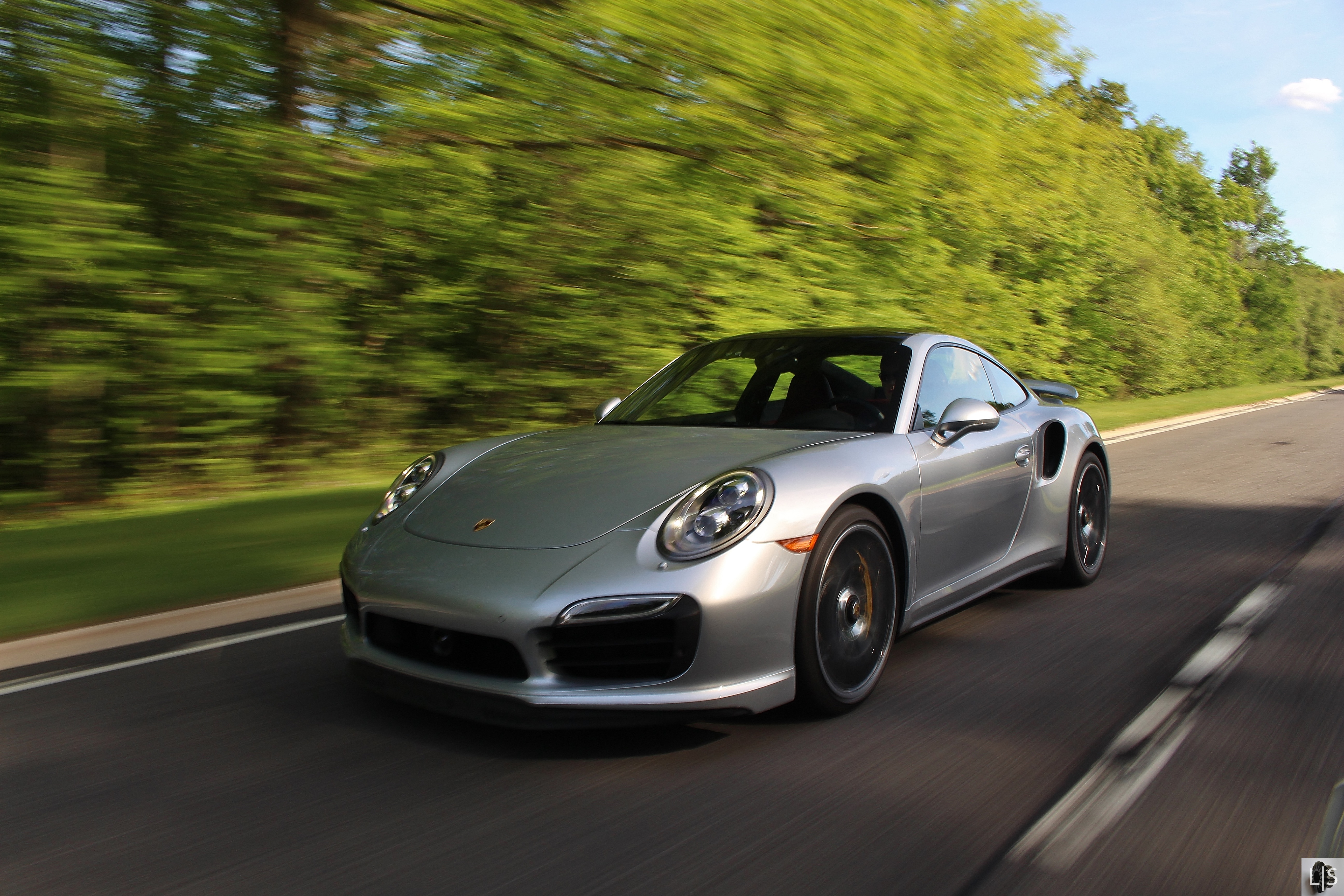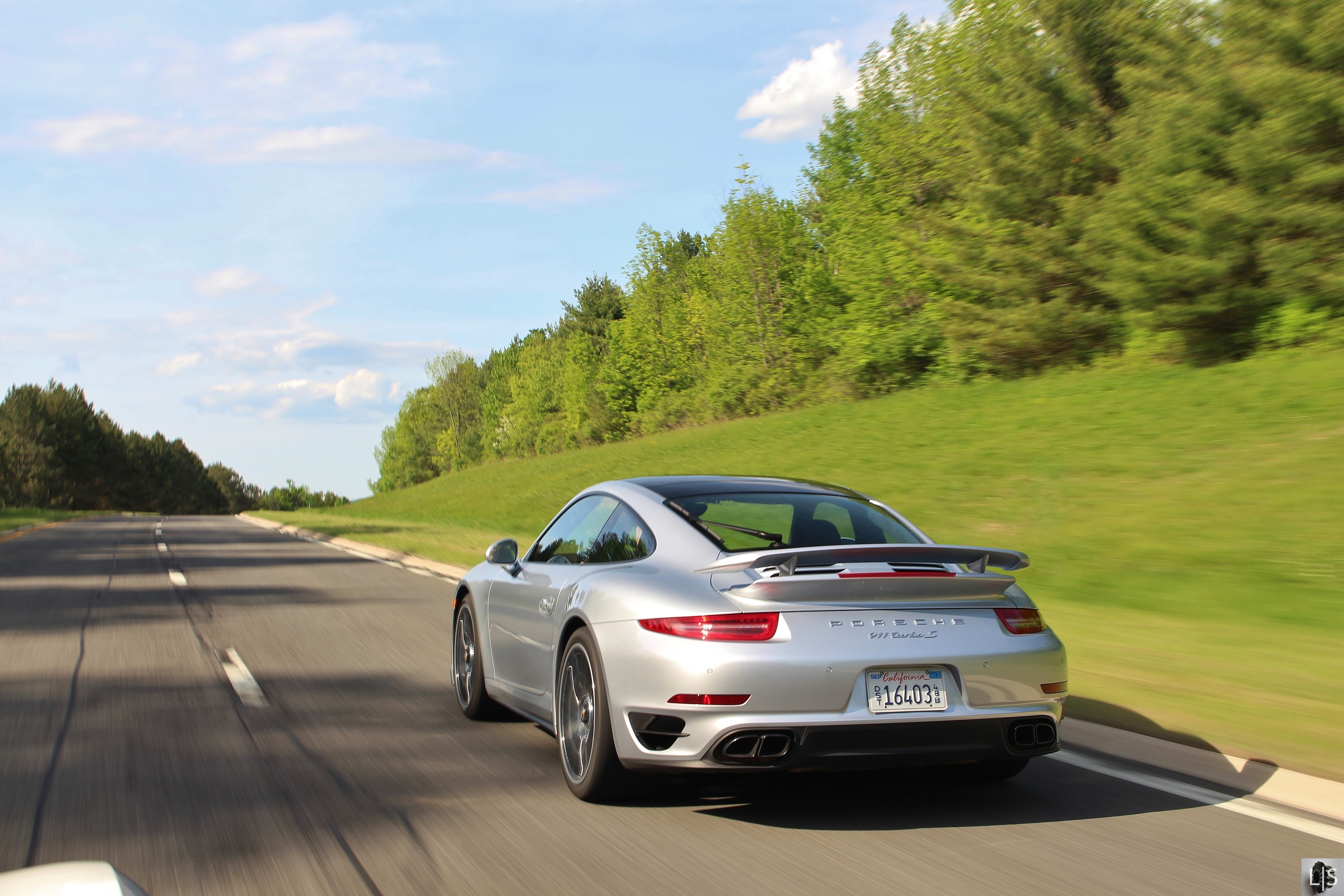t -00:10 As you roll onto an empty road, you push the Sport Plus button. The gearbox snaps down into first gear. The active rear wing deploys, blocking some level of rear visibility. You won’t need it.
t -00:08 The front spoiler has dropped to its most aggressive position. The Pirelli tires collect and throw debris into the wheel wells like a street sweeper.
t -00:05 The car stops. Visibility extends at least a half-mile straight ahead. There isn’t anything but open, dry road.
t -00:03 Apply the brake with your left foot. A final scan of the gauges indicate all clear.
t -00:12 A second check of the road – all clear.
t -00:01 Bury the accelerator. The engine screams to 5,600 rpm and holds. “Launch Control” illuminates on the sport steering wheel.
t -00:00 Lift off (the brake).
This car is ludicrously fast. That speed, speed unlike anything we’ve ever experienced, has been 50 years in the making. The new 991 celebrates 50 years of the 911 with 16 different models. But the one we have here, the Turbo S, is the fastest and most technical 911 ever. Each finely-engineered drivetrain component, each complex accessory system, and each of the countless upgrades – all worth $98,400 more than a standard 911 – have been designed to earn it that title.
t +00:01 There is a pause before you are compressed into the seat. After a slight twitch in the steering wheel, the only thing you feel is the force of acceleration.
t +00:02 By the time you look down, you’ve passed 40 mph.
t +00:03 You’ve passed 60 mph. The acceleration shows no indication of letting up.
t +00:05 Objects that were distant only moments ago are now much closer.
t +00:07 You’ve passed 100 mph. There’s still plenty of road left.
t +00:11 You’ve covered more than a quarter-mile. The speedometer indicates north of 125 mph. It’s time to stop.
The 911 Turbo S is a symphony of Porsche design. Each piece plays a part in creating and controlling 560 hp and 553 lb-ft torque. Just like a NASA mission, there’s an acronym for every system. A twin-turbo 3.8L flat-six is the central component, feeding its power into a 7-speed dual-clutch (PDK) gearbox. From there, Porsche’s new active all-wheel-drive system (PTM) distributes it to where it can have the greatest effect. The Turbo S features center lock hubs that hold extra-wide, 20″ wheels into place. Those multi-spoke wheels hide massive carbon ceramic brakes (PCCB).
t +00:12 Lifting off the accelerator brings another pause. Standing on the brakes undoes everything that happened in the last 11 seconds.
t +00:13 Perhaps the only thing more impressive than the acceleration is the deceleration.
t +00:15 Everything stops. It takes a moment for the nervous laughter to kick in. You sit in awe, the Porsche acts like nothing happened.
You can keep track of these milestones on the standard Sport Chrono Package (SCPP). For the first time, the Turbo S gets dynamic anti-roll bars (PDCC) to keep things level in corners. Four-wheel steering is also standard, articulating the rear wheels up to 2.8 degrees. At low speeds, they move opposite the front wheels to decrease the turning radius. When things get moving quickly, and that tends to happen a lot, they turn with the front wheels to add more stability through corners. Couple that with torque vectoring (PTV Plus) to help rotate the car, and the 911 Turbo S is as fun to drive as it is to launch.
The taut bodywork of the 911 has been stretched to its breaking point on the Turbo S. The need for more air has torn gaping holes in the 911’s skin. Larger front grilles and huge side-intakes provide the extra airflow required for feeding the engine and cooling numerous radiators. Rear diffusers that sit outside the split exhaust tips give that hot air somewhere to go. The underside of the car is completely sealed.
The 991 doesn’t look like a big car, even though its 3.9″ longer between the wheels than the 997 it replaced. This isn’t apparent on the Turbo S because of how wide it is. The rear wheel arches are 1.1″ wider than that of the 4S, which is already nearly an inch wider than the standard 911. From the rear, the angle almost everyone is guaranteed to see, the Porsche has an imposing stance.
Porsche has built a 911 with supercar performance and without supercar drawbacks. Getting in and out is easy. There’s no carbon fiber tub to climb over and no awkwardly hung doors to avoid. Sitting in the Turbo S, especially with the optional glass roof, is akin to being strapped into the cockpit of a fighter jet. The windscreen, roof, and side glass seem to wrap around you.
There’s excellent visibility. You’re seated low in the car and all necessary controls within reach, allowing you to spend most of your time focused on driving. When less than 7 seconds lie between you and 100 mph, situational awareness is key. Of course, this “fighter jet” comes optioned with every exposed surface covered in leather or carbon fiber. You won’t find that factory option on an F-16.
Beginning 40 years ago, the Turbo garnered this nasty reputation of being difficult to drive. The new 911 Turbo S, honestly, isn’t that difficult at all. There’s still enough power to wrench the 305-series Pirelli rear tires loose, even with the traction control on.
That means there’s a bit of a learning curve. It also leads to some interesting experiences. In a deluge, the kind that accompanies the formation of a tornado, the best word to describe the Turbo S is probably “skiddish”. Ask us how we know. But the tornado will pass, the roads will dry up, and you’ll grow accustom to the power delivery. Then, the real fun starts.
The enjoyment of the 911 Turbo S also comes with a stark realization. It’s too fast. No, that isn’t right. Perhaps its best to say the Porsche 911 Turbo S is too good at what it does. Its sole purpose, its raison d’etre, is to be the fastest road car. It isn’t a track car, that job falls to the GT3.
The Turbo S is hard and loud, but it isn’t disruptively hard or headache-inducing loud. But we won’t call it a good sound, either. Even with the artificial exhaust and induction noise, the Turbo S sounds akin to a beehive in a vacuum cleaner. The problem comes with the combination of power and ability. The car has a level of control that transforms the most exciting road into a boring drive.
Imagine rounding your favorite curve in a Porsche Cayman S. At, say, 50 mph, there’s a level of excitement that brings a level of satisfaction. The braking, gear change, apex, acceleration, and exhaust note all combine into that sensory experience we love.
In the Turbo S, that same curve at that same speed requires less braking, no gear change, and very little acceleration. You’ve been robbed of those experiences. So you speed up. Like a junkie, you have to get your fix. You’ll eventually catch yourself bombing down a narrow road at near triple-digit speed just trying recreate the experience you had in the Cayman.
That’s what it’s like to drive the Porsche 911 Turbo S. It’s a mixture of adrenaline and frustration. There almost aren’t enough moments of unbridled acceleration to make daily driving worth it. Almost. Behind the wheel, you get a sense that you’re at the very forefront of automotive engineering. Sure, there are a few drawbacks.
Yes, it doesn’t sound very exotic. Yes, in the eye’s of its critics its still just a 911 – and they’ll say you could own something with a horse on the front for that kind of money. There are only a handful of production cars that rival the 911 Turbo S in a sprint to 60 mph, and almost all of them cost more. All those horse fans will hear is the faint buzzing as they watch the wide hips of the 911 Turbo S leave them behind. They also won’t mange the 20.1 mpg average we returned, either.
The feeling of power doesn’t necessarily always come from the 560 hp. Sometimes it comes from knowing you’re top gun. But there’s another factor at play here. I’ve had this photo of the 911 Turbo by Jeff Allen on my wall for 6 years. The history of the 911 is a storied one, and the Turbo is a part of that history.
For 40 years, Porsche and its fans have celebrated forced induction. Over the course of its history the Turbo has been celebrated and feared, but it has always been respected. There’s less to fear with this new 911 Turbo S, which leaves more time for celebration. And there’s only one way to do that. 3…2…1…
















































































